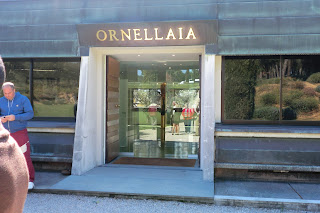I will be exploring these Italian Merlots in a series of upcoming posts beginning with today's post on Tenuta dell'Ornellaia's Masseto, an estate which I had the privilege of visiting last year with a Bordeaux Index team.
The Ornellaia estate encompasses 180 hectares -- 97 of which are planted to vine -- divided between two properties: the 37 hectares of vineyards and the winery on Via Bolgherese and a 60-hectare property called Bellaria which is located to the north of Bolgheri. The Via Bolgherese property is divided into a 30.37-hectare vineyard dedicated to fruit for non-Masseto Ornellaia wines and a 6.63 hectare vineyard dedicated to the growth of Merlot grapes for the fabled Masseto wine.
The Masseto vineyard lies on soil comprised of thin silty clay and broken rock fragments. There is some confusion as to the planting date of the vines with the Masseto website stating the year 1984 as the planting date and other sources (see hermitagewine.com/masseto) using 1981 as the planting date. The older date seems to be more reasonable as the first vintage of the wine is identified as being offered on the market in 1986.
The Masseto vineyard is sub-divided into three distinct sections based on soil characteristics and resultant wines. The lowest section of the vineyard is called Masseto Junior and its soils are characteristically a clay-sand mix. According to the winery the wines produced frrom grapes grown in this section are lighter and serve to smooth out the tannic roughness associated with the wines from the other sections as well as contributing to the overall delicacy of the final product. The middle portion of the vineyard is called Masseto Centrale and has the highest levels of Pliocene clays. Wines produced from these grapes are powerful, concentrated, and tannic. The top portion of the vineyard is located 120 meters above sea level and the soil here consists of loose clays and sand along with pebbles. The soil here is the shallowest in the overall vineyard and the grapes tend to ripen earliest. The wines produced from this section of the vineyard are dense and linear.
 |
| Source: masseto.com |
The Tenuta dell'Ornellaia winemaker is Alex Heinz and the winery's philosophy is "quality without compromise." The quality begins in the vineyard and continues throughout the winemaking process. Grapes are hand-harvested and subjected to a three-part selection process which ensures that only the best berries make it to the fermentation tanks. Suspect grapes are selected-out in the vineyard and before and after de-stemming.
Fermentation is conducted in temperature-controlled stainless steel tanks and oak vats with each block fermented separately. Blocks are aged in wooden barriques for one year prior to being blended into the final wine by the winemaker. The barriques of choice are procured from the Massif Central area in France and have a medium toast. After blending, the wines are returned to the barriques for an additional year of aging. Specific lots of wines may be clarified prior to bottling depending on their characteristics. The wines are aged for an additional year in bottle before being released to the market.
.jpg) |
| Source: masseto.com |
 |
| Source: masseto.com |
Masseto has the distinction of being the first Italian wine to be sold through the Place de Bordeaux, a marketplace ttraditionally reserved for First Growths and a small number of foreign icon wines. Other foreign wines sold through this marketplace include Opus One and Almaviva, both estates associated with Baron Rothschild (decanter.com 11/18/08). The first Masseto vintage offered through this marketplace was the 2006.
On a personal note, this is, for me, one of the great wines of the world. I have had the pleasure of tasting vintages from the mid-90s and and have been consistently blown away by how elegantly they transit time. Our team tasted the 1996 vintage during one of our many local tastings and the notes talk of a terroir-driven wine with coffee notes. The wine was smooth with great texture and complexity. It was concentrated but not weighty.
Masseto has been referred to as the Pétrus of Italy and it is a moniker that, in my opinion, is not without merit. Will there come a day when we refer to Pétrus as the Masseto of France?
©Wine -- Mise en abyme

Funny that folks refer to Masseto as the Petrus of Italy.
ReplyDeleteNot far down the road in the Maremma is a winery, called Petra...While I wouldn't refer to them as the Petrus of Italy, they are an interesting winery making very dramatic wines
Was unaware of this winery until you mentioned it. Looked it up and noted that they also have a monovarietal Merlot offering (Quercegobbe). Their oak regime seems to be less intense than Ornellaia's.
Delete